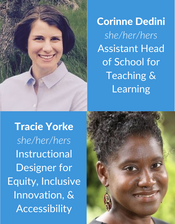 Like a lot of new initiatives, launching points for DEI programs vary widely in schools. The diversity in the website pictures, rainbow ribbons on the bulletin boards, BLM posters in the hallway, and Lunar New Year festivities say, “You are welcome here.” But what’s beyond the welcome mat? In most of our schools, there is a multi-year, all-constituent facing initiative around equity and inclusion. And, in most of our schools, the BIPOC and LGBTQ+ students experience a diminished sense of belonging than that of the straight white students. We’re getting better at leveraging our curriculum to expand empathy and build global citizenship in our students, but if we are paying attention to critical narratives of BIPOC and LGBTQ+ members of our communities, the white heteronormative families are the ones “experiencing” our diversity initiatives. (Cue national outrage around critical race theory over the last year.) So let’s shift gears. In addition to your DEI initiative, do you have an SEL initiative? What does SEL look like for your BIPOC/LGBTQ+ students? When we at One Schoolhouse asked this question, we quickly slipped into deficit thinking as we acknowledged what’s missing. But the other side of that coin is community--and community can’t wait until the phase of the strategic plan where the DEI and SEL initiatives intersect. While we all work to create more wholesome, inclusive communities, we decided that, here at One Schoolhouse, our DEI starting place would be students, and would specifically be identity-honoring spaces for BIPOC/LGBTQ+ students. We have built a series of courses that center identity, places where students can dynamically and critically explore issues of identity, power, liberation, and allyship with peers and a teacher with both personal experience and professional expertise. Our identity courses give students the academic framework to understand their personal experiences from a different perspective. In historically and predominantly white institutions, the experiences of BIPOC/LGBTQ+ students are regularly seen as unique outliers, as stories that challenge but ultimately don’t change the dominant narrative of the school. When these students take courses that correct the erasures and untruths of systemic bias, BIPOC and LGBTQ+ experiences occupy the center rather than the margin. And every year, students tell us that they had no idea there were students just like them in schools across the country. This is how we measure belonging. Equity and emotional safety go hand in hand. If you’re trying to do them separately, you’re missing the point. So be brave. Let your students know about our Asian, Black, Latinx/o/a, and Gender Identity courses. Have a student who feels ostracized in your community but isn’t drawn to one of our identity courses? We center identity in all of our courses. Every course, even the most traditional of the AP courses, makes space for students of all identities to see themselves in the curriculum. Schools are institutions, and it takes time to shift systems to become truly equitable and just institutions. Our current students, however, can't wait for institutional change--they need equity and emotional safety now. Courses that give students an authentic sense of belonging are an opportunity to deliver on your promise to all your families.
0 Comments
Leave a Reply. |
Don't miss our weekly blog posts by joining our newsletter mailing list below:AuthorsBrad Rathgeber (he/him/his) Archives
July 2024
Categories |

 RSS Feed
RSS Feed